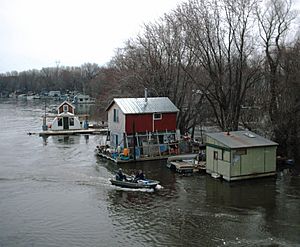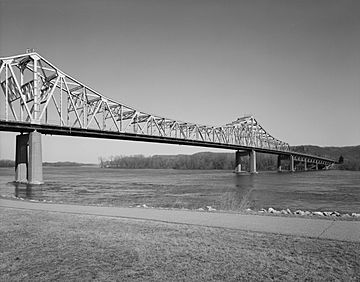Latsch Island facts for kids
|
Nickname: Wolf Spider Island
|
|
|---|---|
 |
|
| Etymology | Official: John A. Latsch, local 20th century Businessman Nickname: Wolf Spider |
| Geography | |
| Adjacent bodies of water | Mississippi River |
| Administration | |
|
United States
|
|
| State | Minnesota |
| City | Winona |
Latsch Island is a special place on the Mississippi River. It is part of the city of Winona, Minnesota. The island is famous for its unique community. Many people there live in boathouses (like houseboats) along the eastern side. These residents often live "off-the-grid." This means they find their own ways to get power and water. Sometimes, when the river floods, the island splits into two. The eastern part is then called Wolf Spider Island.
Contents
Why the Island Has Its Names
Latsch Island is named after John A. Latsch. He was a businessman from Winona in the 1900s. He bought land around Winona and gave it away. This land became part of national parks.
When the river water is very high, Latsch Island can split. The eastern part is sometimes called "Wolf Spider Island." People think this name was chosen to sound scary. The idea was to keep outsiders away from that part of the island. This nickname has been used since at least the early 2000s.
Island History
Early Bridges to the Island
In the 1860s, Latsch Island was not yet formally named. The Winona and St. Peter Railroad used it. They built a railway bridge across the island to Winona. This "swing" bridge opened in May 1871. But it partly fell apart on its first day. The bridge was fixed and used until 1977.
In 1887, a wooden bridge was built. It crossed the Mississippi River over Latsch Island. This bridge connected Winona to Wisconsin. In 1890, Congress allowed Winona to build a new bridge. So, in 1892, the Chicago Bridge and Iron Company built the "Wagon Bridge." This bridge was made of steel and iron. It went over the river and the island into Winona's main street. In 1917, a concrete bridge replaced the old wooden one.
Newer Bridges and World War II
In 1935, a similar bridge in La Crosse, Wisconsin, collapsed. Two people died. To prevent this in Winona, a new bridge was approved in 1938. In 1941, the Main Channel Bridge was finished. It is still used today. It is the main bridge between Latsch Island and the mainland. It carries Minnesota State Highway 43 between Wisconsin and Winona.
The old "Wagon Bridge" was taken down. Its metal was needed for World War II. The concrete bridge was also supposed to be removed. But this was put off until after the war. In 1945, Winona asked the government to return control of the concrete bridge. Their request was granted. The concrete bridge is still in use today.
The Boathouse Community Begins
By the 1930s, Latsch Island was often used as a dumping ground. Around the same time, during the Great Depression, people without homes started living on the island. They were called squatters.
A barge sank on the north side of the island. After this, most river boats started using the south side of the island. The squatters then moved their boathouses to the quiet north side. They knew they would not be bothered there.
Growth and Challenges for the Community
More people moved to the boathouse settlement in the 1960s and 1970s. Many were part of the Hippie movement. But in July 1974, Winona city made a rule. All boathouses needed a license. People in Winona complained. They said Latsch Islanders used city services unfairly.
By March 1975, the city decided not to give out new boathouse licenses after July 1. In 1980, all phone lines to the island were cut. City officials said they found unsafe wires. They also said many boathouses were not safe. In August 1980, the Winona City Council officially approved boathouses.
In 1979, different government groups wanted to ban boathouses. These included the Minnesota Department of Natural Resources and the United States Army Corps of Engineers. In response, the island residents created a council. This council spoke for the islanders. The right to own boathouses went to court. The judge, Dennis Challeen, was part of the island council. He ruled that the residents could keep their boathouses.
Rules and the Community's Fight
The 1980s brought more rules for boathouses. Standards were set for how they floated, their roofs, and how they looked. Rules also covered bathrooms and keeping nearby property safe. But at the same time, the Department of Natural Resources stopped owners from making their boathouses bigger or fixing them up. This created a problem. Owners could not follow one rule without breaking another. If they could not fix their homes, they might be forced to leave.
To deal with this, the Latsch Islanders formed the Winona Boathouses Association in 1981. This was a non-profit group. It officially spoke for the residents. All licensed owners became members and could vote. The Association successfully stopped city officials from getting rid of the boathouse community.
In 1998, Latsch Island officially became part of Winona. The number of boathouses was limited to 101. A rule was made that boathouses could not be repaired if the cost was more than 50% of their original value. This rule was meant to slowly remove the boathouses. However, this repair rule is often not followed. Residents pay a yearly fee to the city to dock their homes. In 2021, this fee was $350 per year.
Who Lives on the Island
The law says there should be only 101 boathouses. But some people think there are more, maybe up to 120. The number of people on the island changes. Harsh winters often make many residents leave for the season. Flooding is another problem that has forced people to leave in the past.
It is thought that about 10% to 20% of the residents stay on the island all year. They remain there no matter the weather.
Island Life and Community
The island community in the 1960s was described as "flower children, poor college students and other non-conformists." In the 1990s, some residents were called "Third-generation boathouse people." Even though it seems like a unique, free-spirited community, Latsch Island has been home to all kinds of people. Past and present residents include judges, professors, artists, and local politicians. It also includes working-class people and those who were homeless.
Latsch Island is close to Winona, connected by a bridge. But life there is still described as "off-the-grid" and private. There is no plumbing on the island. People who have electricity usually get it from solar panels or small generators. Boathouses are often heated by wood stoves. Residents cannot drink water from the river. Instead, many collect rainwater or bring water from Winona.
The community uses the term "river rat" for anyone on the Mississippi River who lives the boathouse lifestyle. These "river rats" prefer "boathouse" over "houseboat." One reason is because of legal rules about "houseboats." Another reason is that their homes are meant to stay docked in one place. So, "boathouse" feels like a better name than "houseboat," which usually means a boat that is also a home.
Images for kids







